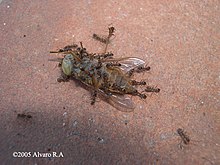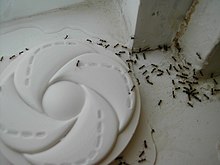Argentine ant
| Argentine ant | |
|---|---|

| |
| Scientific classification | |
| Kingdom: | |
| Phylum: | |
| Class: | |
| Order: | |
| Family: | |
| Subfamily: | |
| Tribe: | |
| Genus: | |
| Species: | L. humile
|
| Binomial name | |
| Linepithema humile (Mayr, 1868)
| |
The Argentine ant, Linepithema humile (formerly Iridomyrmex humilis), is a dark ant native to northern Argentina, Uruguay, Paraguay, and southern Brazil. It is an invasive species that has been established in many Mediterranean climate areas,[1] inadvertently introduced by humans to many places, including South Africa, New Zealand, Japan, Easter Island, Australia, Hawaii, Europe, and the United States.
Description
The worker ants are about 3 millimetres (0.12 in) long and can easily squeeze through cracks and holes no more than 1 millimetre (0.039 in) in size. Queens are two to four times the length of workers. These ants will set up quarters in the ground, in cracks in concrete walls, in spaces between boards and timbers, even among belongings in human dwellings. In natural areas, they generally nest shallowly in loose leaf litter or beneath small stones, due to their poor ability to dig deeper nests. However, if a deeper nesting ant species abandons their nest, Argentine ant colonies will readily take over the space.
German entomologist Dr. Gustav L. Mayr identified the first specimens of Hypoclinea humilis in the vicinity of Buenos Aires, Argentina in 1866. This species was shortly transferred to the genus Iridomyrmex, and finally to Linepithema in the early 1990s.
Distribution
The native range of Argentine ants is limited to around major waterways in the lowland areas of the Paraná River drainage; They have recently spread into parts of Argentina, Brazil, Chile, Colombia, Ecuador, and Peru.[2] The species has become established in at least 15 countries throughout the world, on six continents as well as many oceanic islands.[3]
Global "mega-colony"
According to research published in Insectes Sociaux in 2009, it was discovered that ants from three Argentine ant supercolonies in America, Europe, and Japan, that were previously thought to be separate, were in fact most likely to be genetically related. The three colonies in question were one in Europe, stretching 6,000 km (3,700 mi) along the Mediterranean coast, the "Californian large" colony, stretching 900 km (560 mi) along the coast of California, and a third on the west coast of Japan.
Based on a similarity in the chemical profile of hydrocarbons on the cuticles of the ants from each colony, and on the ants' non-aggressive and grooming behaviour when interacting, compared to their behaviour when mixing with ants from other super-colonies from the coast of Catalonia in Spain and from Kobe in Japan, researchers concluded that the three colonies studied actually represented a single global super-colony.
The researchers stated that "enormous extent of this population is paralleled only by human society", and had probably been spread and maintained by human travel.[4]
Behavior

They have been extraordinarily successful, in part, because different nests of the introduced Argentine ants seldom attack or compete with each other, unlike most other species of ant. In their introduced range, their genetic makeup is so uniform that individuals from one nest can mingle in a neighboring nest without being attacked. Thus, in most of their introduced range they form supercolonies. "Some ants have an extraordinary social organization, called unicoloniality, whereby individuals mix freely among physically separated nests. This type of social organization is not only a key attribute responsible for the ecological domination of these ants, but also an evolutionary paradox and a potential problem for kin selection theory because relatedness between nest mates is effectively zero."[5] In contrast, native populations are more genetically diverse, genetically differentiated (among colonies and across space), and form colonies that are much smaller than the supercolonies that dominate the introduced range. Argentine ants in their native South America also co-exist with many other species of ants, and do not attain the high population densities that characterize introduced populations.[6]
Reproduction
Like workers in many other ant species, Argentine ant workers are unable to lay reproductive eggs but can direct the development of eggs into reproductive females; the production of males appears to be controlled by the amount of food available to the larvae.[7] The queens seldom or never disperse in winged form. Instead, colonies reproduce by budding off into new units. As few as ten workers and a single queen can establish a new colony.
Impact
The ants are ranked among the world's 100 worst animal invaders.[8] In its introduced range, the Argentine ant often displaces most or all native ants. This can, in turn, imperil other species in the ecosystem, such as native plants that depend on native ants for seed dispersal, or lizards that depend on native ants for food. For example, the recent severe decline in coastal horned lizards in southern California is closely tied to Argentine ants displacing native ant species on which the lizards feed.[9]
Argentine ants sometimes tend aphid colonies,[10] and their protection of this plant pest can cause problems in agricultural areas by protecting plant pests from predators and parasitoids.[11] In return for this protection the ants receive a food as an excretion, known as honeydew. Thus, when Argentine ants invade an agricultural area, the population densities of these plant parasites increase and so too does the damage they cause to crops.
Pest control

Argentine ants are a common household pest, often entering structures in search of food or water (particularly during dry or hot weather), or to escape flooded nests during periods of heavy rainfall. Argentine ant colonies almost invariably have many reproductive queens, as many as eight for every 1,000 workers, so eliminating a single queen does not stop the colony's ability to breed. When they invade a kitchen, it is not uncommon to see two or three queens foraging along with the workers.
Due to their nesting behavior and presence of numerous queens in each colony, it is generally impractical to spray Argentine ants with pesticides or to use boiling water as with mound building ants. Spraying with pesticides has occasionally stimulated increased egg-laying by the queens, compounding the problem.[12] Pest control usually requires exploiting their omnivorous dietary habits, through use of slow-acting poison bait, which will be carried back to the nest by the workers, eventually killing all the individuals, including the queens. It may take four to five days to eradicate a colony in this manner.
Researchers from the University of California, Irvine, have developed a way to use the scent of Argentine ants against them.[13] The exoskeletons of the ants are covered with a hydrocarbon-laced secretion. They made a compound that is different, but similar, to the one that coats the ants. If the chemical is applied to an ant, the other members of the colony will kill it.[14] The chemical method may be effective in combination with other methods.
See also
- Pharaoh ant, with which the Argentine ant can be confused
References
- ^ Neil D. Tsutsui, Andrew V. Suarez, David A. Holway & Ted J. Case (2001). "Relationships among native and introduced populations of the Argentine ant (Linepithema humile) and the source of introduced populations" (PDF). Molecular Ecology. 10 (9): 2151–2161. doi:10.1046/j.0962-1083.2001.01363.x. PMID 11555258.
{{cite journal}}: CS1 maint: multiple names: authors list (link) - ^ Alexander L. Wild (2004). "Taxonomy and distribution of the Argentine ant, Linepithema humile (Hymenoptera: Formicidae)" (PDF). Annals of the Entomological Society of America. 97 (6): 1204–1215.
- ^ Andrew V. Suarez, David A. Holway & Ted J. Case (2001). "Patterns of spread in biological invasions dominated by long-distance jump dispersal: Insights from Argentine ants". Proceedings of the National Academy of Sciences. 98 (3): 1095–1100. doi:10.1073/pnas.98.3.1095. JSTOR 3054827.
- ^ Walker, Matt (1 July 2009). "Ant mega-colony takes over world". Earth News. BBC News. Retrieved 2 July 2009.
- ^ Tatiana Giraud, Jes S. Pedersen & Laurent Keller (2002). "Evolution of supercolonies: the Argentine ants of southern Europe". Proceedings of the National Academy of Sciences. 99 (9): 6075–6079. Bibcode:2002PNAS...99.6075G. doi:10.1073/pnas.092694199. JSTOR 3058627. PMC 122904. PMID 11959924.
- ^ "Success of introduced Argentine ants tied to reduced genetic variation". University of California, San Diego.
- ^ L. Passera, L. Keller & J. P. Suzzoni (1988). "Control of brood male production in the Argentine ant Iridomyrmex humilis (Mayr)". Insectes Sociaux. 35 (1): 19–33. doi:10.1007/BF02224135.
{{cite journal}}: Unknown parameter|month=ignored (help) - ^ "Super ant colony hits Australia". BBC News. 14 August 2004.
- ^ "Proliferation of Argentine ants in California linked to decline in coastal horned lizards". Science Daily. March 5, 2002.
- ^ C. M. Bristow (1991). "Are ant–aphid associations a tritrophic interaction? Oleander aphids and Argentine ants". Oecologia. 87 (4): 514–521. doi:10.1007/BF00320414. JSTOR 4219728.
- ^ Crystal D. Grover, Kathleen C. Dayton, Sean B. Menke & David A. Holway (2008). "Effects of aphids on foliar foraging by Argentine ants and the resulting effects on other arthropods" (PDF). Ecological Entomology. 33 (1): 101–106. doi:10.1111/j.1365-2311.2007.00942.x.
{{cite journal}}: CS1 maint: multiple names: authors list (link) - ^ Ants - Kill Ants
- ^ Ants' own chemical may control them
- ^ Rivenburg, Roy (September 15, 2006). "UCI makes ants go ape by giving them B.O." Los Angeles Times.
{{cite news}}: CS1 maint: date and year (link)
External links
 Media related to Linepithema humile at Wikimedia Commons
Media related to Linepithema humile at Wikimedia Commons Data related to Linepithema humile at Wikispecies
Data related to Linepithema humile at Wikispecies- Matt Daugherty. "Argentine ant (Linepithema humile)". Center for Invasive Species Research. University of California, Riverside.
- Alex Wild. "How to identify the Argentine ant, Linepithema humile". Myrmecos.
